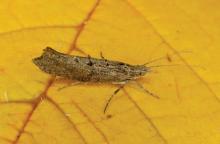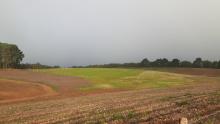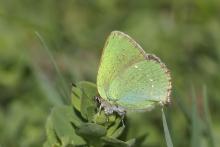The collaboration has seen significant progress at both working and restored quarries. The summer months offer the best opportunity for spotting butterfly species at our sites. However, butterflies face many challenges with two thirds of species now showing population declines nationally. Butterflies are under threat due to a variety of reasons including climate change and extreme weather events, habitat destruction, intensive agricultural techniques, loss of wildflower meadows, wetland drainage schemes, removal of hedgerows and woodland clearance.
Despite these clear pressures on butterfly populations, research by Butterfly Conservation has proven that with careful habitat design and habitat management, sites can mitigate against these events. CEMEX is at the forefront of implementing recommendations on their restored sites and have already had tremendous success in reversing population trends. Other land owners are now following their example with a definite feeling that we are turning the tide on the population declines.
• In Warwickshire with the help of Butterfly Conservation CEMEX was instrumental in first saving the Small Blue butterfly from regional extinction, but not content with this then reversed its fortunes. From the original three remaining Small Blue colonies which were all under threat, the number of colonies has now grown to 23, many of the colonies on CEMEX or former CEMEX sites. Warwickshire now has more colonies recorded than ever before. The work in Warwickshire has also helped conserve other rare butterflies including the Grizzled and Dingy Skippers, Dark Green Fritillary and Chalk Carpet Moth.
• In Northumberland RSPB and CEMEX are working together at Divethill quarry preserving and creating the rare habitat called Whin grassland. During 2019 the Small Pearl-Bordered Fritillary was found on site. This was good news as the species is an important pollinator for the wildflower assemblage found in the grassland. Future restoration at the site will increase the area of rare grassland and include the addition of important native woodland fringes.
• Sandgate quarry, Blue Adonis – The Blue Adonis is one of the UK’s rarest butterflies and is found in only a few colonies doted along the south east coast. The butterfly has very specific requirements for its habitat including well cropped grass on a south facing meadow. The meadow also needs to support the butterfly’s host plant which is Horseshoe Vetch. As part of the restoration work at Sandgate a habitat has been created that perfectly matches these requirements. With a colony already established at the nearby Cissbury Ring we have been lucky enough to attract this rare species to our site. During May 2019, a healthy population was discovered on site. Key measures going forward are to preserve the habitat and ensure the colony is protected.
• Raynes quarry in Wales is adjacent to Mynydd Marian SSSI which is home to a rare colony of Silver Studded Blue. RSPB and CEMEX have implemented a Biodiversity Action Plan to focus restoration work on habitat creation to improve the site for a bird species called the Chough, Wildflowers and the Silver-studded Blue butterfly. The quarry is developing a habitat called Calcareous grassland on restored areas of the site. This work has been ongoing for a number of years and utilised hay from the SSSI as a source of grass and wildflower seeds. The butterfly’s main food plant is Common Rock Rose, which is now found on site. Surveys are carried out annually. To date, 2019 has shown that there are over 80 species flowering plant found in the grassland which already supports large and abundant butterfly populations. Some of the species found at the quarry this year included the Small White, Gatekeeper, Ringlet, Small Heath and also the Shaded Broad Bar Moth. The focus now is to encourage the Silver Studded Blue to site. The Chough continues to use the site for nesting and rearing its young during the summer months.
• Ancient woodland that flanks CEMEX Newbridge quarry in North Yorkshire is rich in Flora and Fauna and it is also home to the most northerly population of Duke of Burgundy, a tiny pretty butterfly whose food plant, Cowslip, grows in the areas of open woodland. Restoration has encouraged Cowslips to colonise the grassland-wood fringe and we are hopeful the Duke of Burgundy will follow soon.









